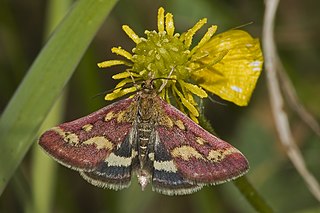| Almita | |
|---|---|
| Scientific classification | |
| Kingdom: | Animalia |
| Phylum: | Arthropoda |
| Class: | Insecta |
| Order: | Lepidoptera |
| Family: | Crambidae |
| Tribe: | Crambini |
| Genus: | Almita B. Landry, 1995 [1] |
| Type species | |
| Almita texana [2] B. Landry, 1995 | |
| Almita | |
|---|---|
| Scientific classification | |
| Kingdom: | Animalia |
| Phylum: | Arthropoda |
| Class: | Insecta |
| Order: | Lepidoptera |
| Family: | Crambidae |
| Tribe: | Crambini |
| Genus: | Almita B. Landry, 1995 [1] |
| Type species | |
| Almita texana [2] B. Landry, 1995 | |

The Crambidae are the grass moth family of lepidopterans. They are variable in appearance, the nominal subfamily Crambinae taking up closely folded postures on grass stems where they are inconspicuous, while other subfamilies include brightly coloured and patterned insects which rest in wing-spread attitudes.

The Pyraloidea are a moth superfamily containing about 16,000 described species worldwide, and probably at least as many more remain to be described. They are generally fairly small moths, and as such, they have been traditionally associated with the paraphyletic Microlepidoptera.

Urodidae or "false burnet moths" is a family of moths in the lepidopteran order. It is the type genus in the superfamily, Urodoidea, with three genera, one of which, Wockia, occurs in Europe.

Scythrididae is a family of small moths in the superfamily Gelechioidea. The family is sometimes included in the Xyloryctidae as a subfamily Scythridinae, but the Xyloryctidae themselves have sometimes been included in the Oecophoridae as subfamily. Scythrididae adults are smallish to mid-sized moths, which when at rest appear teardrop-shaped.
La is a genus of moths of the family Crambidae described by Stanisław Błeszyński in 1966. There are four species in the genus, three of which have been given punning names.

Crambinae is a large subfamily of the lepidopteran family Crambidae, the crambid snout moths. It currently includes over 1,800 species worldwide. The larvae are root feeders or stem borers, mostly on grasses. A few species are pests of sod grasses, maize, sugar cane, rice, and other Poaceae. The monophyly of this group is supported by the structure of the tympanal organs and the phallus attached medially to the juxta, as well as genetic analyses.

Alucita hexadactyla is a "micromoth" of the many-plumed moth family (Alucitidae). It is found in Eurasia. It was previously thought to also occur in North America, but a 2004 study showed that the North American species are distinct and separate.

Catharylla is a genus of moths of the family Crambidae. It has Neotropical distribution from Costa Rica to southern Brazil.

The Obtectomera is a clade of macro-moths and butterflies, comprising over 100,000 species in at least 12 superfamilies.
Hydropionea is a genus of moths of the family Crambidae. The 13 described species are distributed in Central and South America.
Micrelephas is a genus of moths of the family Crambidae.
Undulambia is a genus of moths of the family Crambidae.

Parapediasia is a genus of moths of the family Crambidae.
Sparganothina is a genus of moths of the family Tortricidae.

Alucita is the largest genus of many-plumed moths ; it is also the type genus of its family and the disputed superfamily Alucitoidea. This genus occurs almost worldwide and contains about 180 species as of 2011; new species are still being described and discovered regularly. Formerly, many similar moths of superfamilies Alucitoidea, Copromorphoidea and Pterophoroidea were also placed in Alucita.
Alexander Barrett Klots was an American entomologist who specialised in Lepidoptera.
Almita texana is a moth in the family Crambidae. It was described by Bernard Landry in 1995. It is found in North America, where it has been recorded from Texas.
Almita portalia is a moth in the family Crambidae. It was described by Bernard Landry in 1995. It is found in North America, where it has been recorded from Arizona and California.
The Macroheterocera are a well supported clade of moths that are closely related to butterflies and other macro-moths.